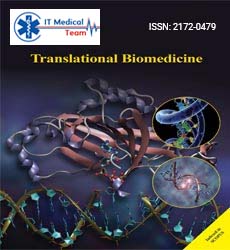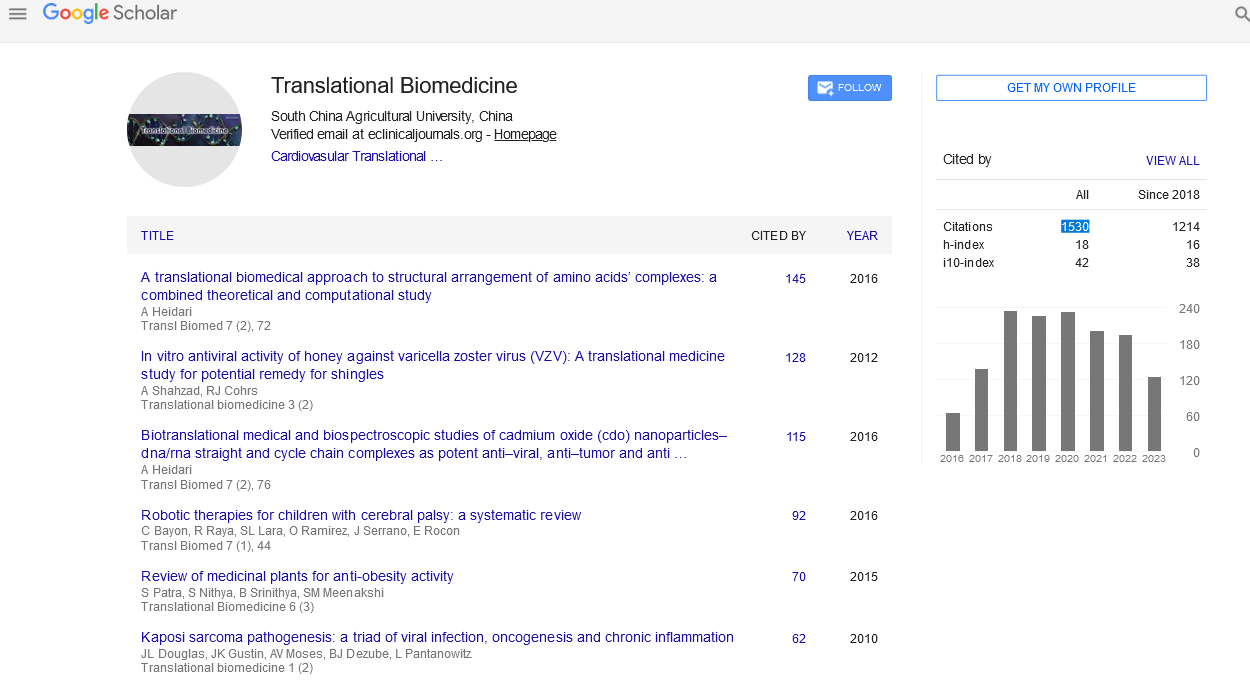Mini Review - (2023) Volume 14, Issue 2
Commentary Promoting the Purpose of Academic Department Research the Establishment of a Translational Medicine Center
James Artaud*
Department of Translational medicine, Australia
*Correspondence:
James Artaud, Department of Translational medicine,
Australia,
Email:
Received: 28-Jan-2023, Manuscript No. Iptb-23-13491;
Editor assigned: 30-Jan-2023, Pre QC No. Iptb-23-13491 (PQ);
Reviewed: 13-Feb-2023, QC No. Iptb-23-13491;
Revised: 16-Feb-2023, Manuscript No. Iptb-23-13491 (R);
Published:
23-Feb-2023, DOI: 10.36648/2172- 0479.14.2.285
Abstract
However, the function of a multidisciplinary center within the framework of
a single academic department has received little attention. The Center for
Translational Medicine was established in 2003 by Jefferson Medical College's
Department of Medicine in order to create a program of excellence in research,
link basic research with clinical research programs, improve trainee education,
maximize space and resources, and facilitates multidisciplinary research. In this
section, we demonstrate the Centre’s success and describe its structure. The
Centre’s development has resulted in an increase in total funding, an increase in
the number of students and residents conducting translational research, a more
efficient use of space, the creation of multidisciplinary research projects, and a
significant increase in the number of individual and programmatic grants funded
by the federal government. The department and the university have benefited
significantly from the Centre’s establishment, despite its challenges.
Keywords
Academic departments; Centers of Excellence; Translational medicine
Introduction
Teams of investigators who frequently congregate around a single
or group of core facilities that support their research efforts have
replaced the single investigator working with a relatively small
group of postdoctoral fellows, graduate students, and research
assistants [1]. An "interdisciplinary" team is one with faculty
from multiple disciplines working on the same project, while
a "multidisciplinary" team is one with faculty from multiple
disciplines working independently on different aspects of the
project. Numerous research "centers" and "institutes" have
been established at academic medical centers all over the United
States as a result of the formation of multidisciplinary and
interdisciplinary teams of researchers [2]. Numerous institutions
have established institution-wide Centers for Translational
Medicine as a result of the development of a National Institute
of Health mandate for the establishment of Centers for the
Clinical and Translational Sciences. The findings of a survey of
604 such centers and institutes at research-intensive universities were presented by Mallon and Burt in the year [3]. The value of
establishing a research center within the framework of a single
department has not been the subject of any studies. A medical
school, which is made up of between 10 and 15 distinct divisions,
can be thought of as a miniature version of a department of
medicine; a single division might be larger than the majority, if
not all, of medical school departments. In the past, department
chairs have attempted to establish research programs in each
department division, but these programs frequently had
little intellectual or scientific interaction [4]. We established a
centralized center to support and nurture departmental research
five years ago, reorganizing the structure of our Department of
Medicine's research: The Translational Medicine Center. We
hypothesized that the establishment of a Center for Clinical and
Translational Sciences would improve the department's research
output in the following ways: establishing a connection between
the activities of the department's research and the department's
and the medical centre’s strategic clinical goals, making it easier for
academic clinicians, basic scientists, and the practice community to interact with one another, and making the most of cuttingedge
technology [5]. Also getting rid of the silo mentality that had
created small but independent research fiefdoms and empires
within the department and providing a platform for scientific
interaction to make it easier for all researchers, regardless of
their organ of interest, to exchange ideas and technology.
The Department's Research Program's
Reorganization
The specialties of haematology, nephrology, endocrinology,
pulmonary and critical care medicine, infectious disease,
rheumatology, and cardiology were the recipients of these
honours. However, the majority of grants were distributed
across one of three silos: There were a total of six RO1s from
three researchers working in infectious diseases, four from
three researchers working in rheumatology, and seven from
six researchers working at The Cardeza Center for Hematologic
Research [6]. The faculty in the various divisions did not
collaborate on grant applications or publications in the peerreviewed
literature, indicating that each of these silos functioned
independently with virtually no interaction of a technical
or intellectual nature. Red cell abnormalities, hematologic
malignancies, bleeding, and haemostasis were just some of
the topics that individual Cardeza researchers investigated,
despite the fact that the Cardeza Centre’s primary focus was on
haematology research [7]. Even though one of the researchers
in rheumatology was a part of a program project grant that was
housed in another department, there were no program project
grants in the Department of Medicine. We started building the
Center for Translational Medicine in 2002 so that the Department
of Medicine could have a central location for expanding research
[8]. The objective was to hire people based on their excellence
in translational research rather than their specialization. The
open-plan construction of the Center allowed for maximum
adaptability and facilitated interactions between researchers,
students, and staff. A genomics and gene discovery core, a gene
transfer core, and a molecular imaging core made up the Center.
And a core in cell biology and physiology, Endocrinology and
infectious diseases research programs were able to move into the
same building as the Center for Translational Medicine and the
Cardeza Center for Haematology Research thanks to additional
space that was provided adjacent to the new Center. This allowed
all departmental research to be conducted in a single facility [9].
Shortly before the construction was finished, three important
leadership positions were filled: a director of the Clinical and
Outcomes Research Program, a clinical director of the Center, and
a director of the Center [10].
Discussion
He was first, and he had the majority of centers. He was called
modest or marginal. Because they lacked substantial resources
and had no control over faculty appointment and compensation,
small centers had to collaborate with academic departments and
other centers to achieve their goals and mission. The second type
of center was characterized as having a significant role in the
organization and governance of the medical school and university
researchers who crossed departmental lines, direct reporting
to a university president or provost, a large staff, substantial
financial resources, and a high level of institutional prestige and
visibility. This type of center only represented 10–15% of centers.
Twenty or fewer faculty members and ten or fewer professional
researchers, postdoctoral appointees, and graduate students
made up three quarters of all centers. The average size was
more than 20,000 square feet and the funding was $5.3 million
on average. We report the first departmental-based center for
translational medicine, to the best of our knowledge. One way to
look at our experience with a translational medicine center in a
medical school or university is to look at the larger observations
of research centers. The successful establishment of a center
is dependent on institutional support and dedication, as is the
case with successful university-based centers. Without the strong
commitment of the University President and the Dean of the
College of Medicine, our Center would not have been successful.
The Medical College provided the capital for equipping the core
facilities with cutting-edge technology and packages for initial
recruitment efforts, while the University funded the space's
construction. However, the Centre’s success in obtaining grant
support from Federal agencies, development efforts, on-going
support from existing endowments that were tasked with
supporting the Center, and departmental funding have supported
the Centre’s growth. The Center has more faculties, receives
more extramural funding, and occupies a larger space than the
typical institutional center despite being department-based. In
addition, despite being a part of the Department of Medicine,
the Center has attracted a lot of attention through publications
from universities, medical schools, and departments, as well as
fundraising events.
References
- Mallon WT (2006) The benefits and challenges of research centers and institutes in academic medicine: findings from six universities and their medical schools. Acad Med 81: 502–512.
Indexed at, Google Scholar, Crossref
- Crist TB, LaRusso NF, Meyers FJ, Clayton CP, Ibrahim TV (2003) Centers institutes and the future of clinical departments: part II. Am J Med 115: 745–747.
Indexed at, Google Scholar, Crossref
- Arthur AF, Thomas LF, David JW (2010) Commentary: Advancing the Research Mission in an Academic Department: The Creation of a Center for Translational Medicine. Clin Transl Sci 3: 178-181.
Indexed at, Google Scholar, Crossref
- Steven LK (2012) Advancing the Education Mission. Acad Med 87: 991-992.
Indexed at, Google Scholar, Crossref
- Keyes JA (1994) Preserving and advancing the academic mission in health care reform. Acad Med 69: 642.
Indexed at, Google Scholar, Crossref
- Nasser N, Grady D, Balke CW (2011) Commentary: Improving Participant Recruitment in Clinical and Translational Research. Acad Med 86: 1334-135.
Indexed at, Google Scholar, Crossref
- Pincus HA (2009) Commentary: Challenges and Pathways for Clinical and Translational Research: Why Is This Research Different From All Other Research. Acad Med 84: 411-412.
Indexed at, Google Scholar, Crossref
- Himmelstein J, Bindman AB (2013) Advancing the University Mission through Partnerships with State Medicaid Programs. Acad Med 88: 1606-1608.
Indexed at, Google Scholar, Crossref
- Rajmohan P, Kumar A, Mohanan MA (2021) Clinical and Laboratory Predictors of Mortality in Patients with SARS-CoV-2 Infection in A Tertiary Care Center of Central Kerala, India - A Case control Study. Casp J Health Res 6: 111-120.
Google Scholar
- Joshua EA, Meenakshi, Sellamuthu K (2022) Air Leak Syndrome and Coronavirus Disease 2019 (Covid-19) Pneumonia a Case Series. Int j med sci res 2: 25-28.
Google Scholar
Citation: Artaud J (2023) Commentary Promoting the Purpose of Academic Department Research the Establishment of a Translational Medicine Center. Transl
Biomed, Vol. 14 No. 2: 110.





